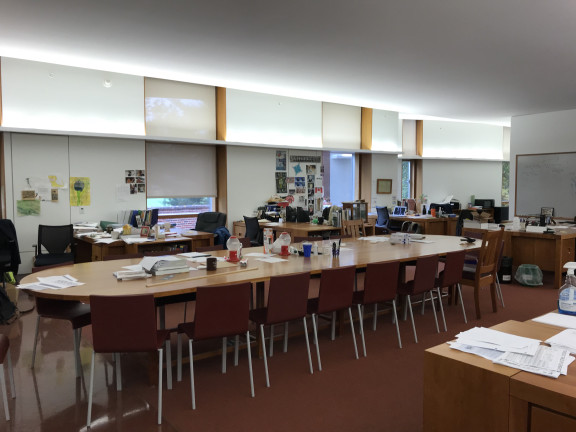50p

Exploring Creative Teaching Spaces
After a blurry-eyed departure time and some seats uncomfortably close to the washroom on the plane, six Brentwood staff spent the better part of four days actively investigating the creative use of teaching space for a potential new academic building at the north end of campus. Backed onto the end of the October break, our intrepid group of explorers had the opportunity to visit exceptional facilities at Deerfield College, MIT, Harvard, Phillips Andover, and Lab Central.
After checking into our boutique hotel, we started our trip at Deerfield College, where we had a detailed and well-thought-out itinerary laid out for us by their administration team. Collectively, we were struck by the beautiful new Math and Science building, with its exquisite use of space and the ‘meandering river’ that lead to the student center at the hub of the building. It was a warm space that was actively used by students prepping for their next classes. With a coffee shop adjacent, it was a place anyone could be comfortable working in. The building also had some very interesting teacher spaces with large conference tables, which were accessible to all, as well as a series of pods for four staff to do their individual work. The concept looked like something that would readily enable a group of teachers to collaborate and develop innovative assignments, projects, and units. After a remarkable lunch, not dissimilar to ones provided for us by our co-workers in Crooks Hall, we observed some classes, ventured to the maker space and toured the impressive athletic facilities. Many of their buildings and programs reminded us of Brentwood, but it was nice to see the little twists and turns they made to work for their students.
The next day, we ventured to the new undergraduate chemistry labs at MIT and explored their interpretation of practical, yet adaptable spaces. While the eye-wash station gave one of our members a bit of a problem, the tour was fascinating and inspired a great deal of discussion within our team. The lab and write-up spaces were located in close proximity to each other but were far enough apart to create separation for different activities.
Another highlight for our team was traveling to Phillips Andover. A large, highly-successful school north of Boston, we had a thorough tour of their science building and of some of their other buildings as well. Much larger than Brentwood, it had a similar look to that of Harvard and it was immediately apparent why students would want to study there. It had beautiful buildings, incredible landscapes and every facility a student could desire. The science classrooms were typical in design but did have a neat feature of having some adaptable tables for different setups; labs, and student use. There were ones we had not see before and thought could be useful for spaces we create in the future.
In the midst of our BFIT Whole Life Challenge, we desperately sought refuge in the dreamy, well-crafted cannoli from one of Boston’s best Italian bakeries. These are not to be missed! If you are ever in town, make sure you get to little Italy for these delicacies - there is a reason every bakery has a line-up at 9:00 pm in the evening.
Once we recovered from the excess sugar, we spent a couple of hours the next morning at the Wyss Institute, a collaborative venture with Harvard, MIT, Boston College and several area hospitals to support innovation in biomedical technology. The research is at a level where we weren’t allowed to take photos. What surprised us what that these are truly collaborative efforts in the world of research instead of everyone hiding away. There is an expectation if you’re researching in this space, that you are sharing your findings with the others.
After lunch, we spent time in conversation with the instructor of Harvard’s chemistry of food program. A popular program with students not majoring in chemistry, the instructor gave us plenty of food for thought in consideration of the design of our own programs here at Brentwood. The teachable moments that are specific in scientific nature that come from a cooking lab are plentiful and diverse, and stretch beyond the science. Her classrooms look like traditional chemistry classrooms but come equipped with all the equipment needed for creating meals in a Food Safe environment. The application of food to the use of specific skills in chemistry was fascinating and it was obvious why the program was popular. As a group, we were curious about providing a similar opportunity for our own students.
Our last academic visit was to Lab Central. A cutting-edge facility looking to enable bio-chemical start-ups, this unique company had a series of thoughtful collaboration spaces adjacent to all of the traditional labs that they had set up. Impressively, they were all used extensively and they had a buzz about them. Interestingly, one space which looked to be the most relaxed with big, soft couches was the only one not in use. The booth style tables with room for four or five seemed to be the most popular.
All in all, the trip was a busy one and we spent much of the time interviewing tour guides and exploring cutting-edge places of learning and development. This lead to many extensive conversations about the vision for our new academic building. We finished the tour with a visit to the TD Garden, and while the result was not a good one for the Oiler fan in our company, it capped a great trip. The conversations and relationships that were forged through a trip like this create amazing opportunities and we all strongly encourage other team members to join the conversation for this new structure as it unfolds in the upcoming months.